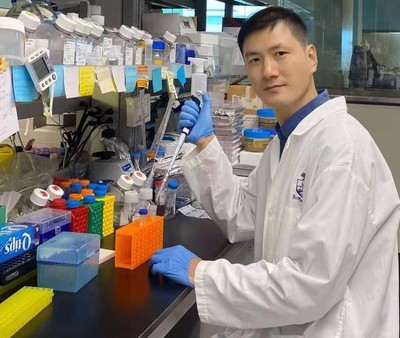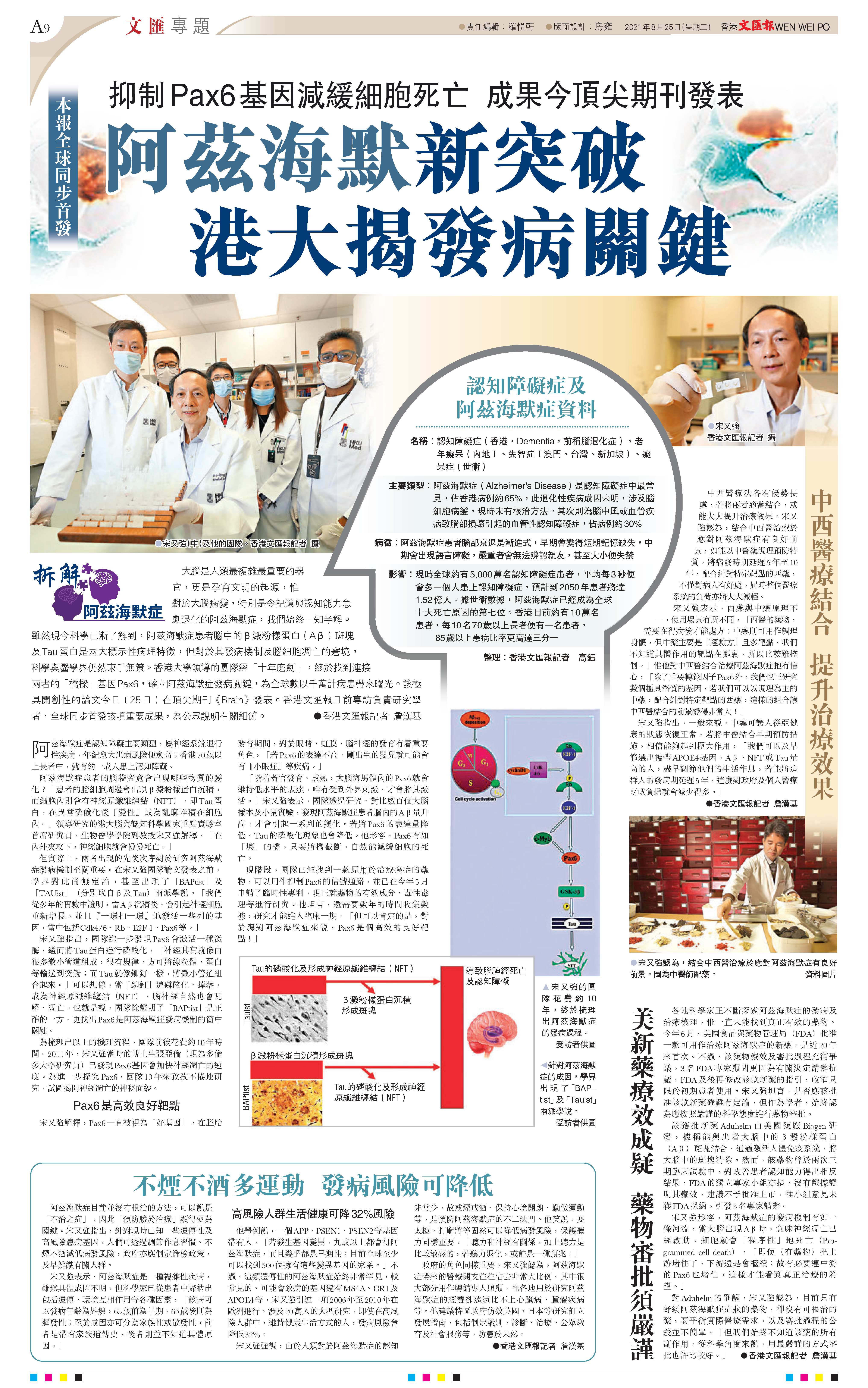Aug 25, 2021
Press Release: HKUMed identifies an important gene linking the two hallmark pathological features: Amyloid β (Aβ) plaques and neurofibrillary tangles (NFT) in Alzheimer’s disease (AD)
Press Release (2021-08-25):
HKUMed identifies an important gene linking the two hallmark pathological features: Amyloid β (Aβ) plaques and neurofibrillary tangles (NFT) in Alzheimer’s disease (AD)

The research team includes (front row from left): Mr Zhang Yi, Prof. Jin Dong-yan, Professor of the School of Biomedical Sciences, HKUMed, Dr Song You-qiang, Associate Professor of the School of Biomedical Sciences, HKUMed, Ms Dana S.M. Wong; (back row from left) Ms Li Siwen and Mr Yue Ming; and (below) Dr Zhang Yalun.

A research team of LKS Faculty of Medicine, The University of Hong Kong (HKUMed) has identified an important gene linking the two hallmark pathological features: Amyloid β (Aβ) plaques and hyperphosphorylated tau (p-tau) forming neurofibrillary tangles (NFT) in Alzheimer’s disease. The gene called Pax6 is upregulated significantly in Alzheimer's disease brains and inhibition of Pax6 could reduce tau phosphorylation and amyloid β-induced neuronal death. This study has the potential to offer a novel therapeutic target for Alzheimer’s disease. This study has been published in Brain (Oxford).
Pax6 promotes hyperphosphorylated tau (p-tau) and neuronal death in Alzheimer’s disease
Alzheimer’s disease (AD) is a progress neurodegenerative disease. The pathological manifestation of Alzheimer's disease is the deposition of amyloid β peptide (Aβ) and abnormal phosphorylation of Tau protein in the brain. The molecular pathways linking β amyloid and p-tau are still not clear. The authors first examined 176 AD-affected brains and 187 normal control brains and detected that the Pax6 was upregulated in AD brains. GSK-3β is revealed as a downstream target of Pax6 and GSK-3β protein is a kinase involved in tau hyperphosphorylation and NFT formation.
‘Our work discovered the missing link between amyloid β and hyperphosphorylated tau. Moreover, this novel work in mechanism provides a unique opportunity to inhibit Pax6 signaling pathways by repurposing FDA approved drugs, of which a provisional USA patent has been filled,’ said Dr Song You-Qiang, Associate Professor at the School of Biomedical Sciences, HKUMed, who initiated the study.
‘Although the cell cycle hypothesis of Alzheimer’s disease has been proposed for many years, we provide the detailed mechanism by which it regulates the two pathological features in Alzheimer’s disease,’ said the first author Dr Zhang Yalun.
About the research team
The study was conducted by Dr Song You-qiang’s research team at School of Biomedical Sciences and The State Key Laboratory of Brain and Cognitive Sciences, The University of Hong Kong (HKU). The HKUMed team included former students Dr Zhang Yalun, Mr Zhang Yi, Mr Cheung Tao Ng , Mr Chau Wing-hin, Dr Jia Yizhen, Dr Zhang Zhigang; current students: Mr Zhang Yi, Mr Yue Ming, Ms Li Siwen, Ms Dana S. M. Wong and in collaboration with Prof Jin Dong-yan at School of Biomedical Sciences, HKUMed and Dr Chiu Kin in the Department of Ophthalmology.
The study was collaborated with Tanz Centre for Research in Neurodegenerative Diseases, University of Toronto, including Dr Christopher Bohm, Dr Jennifer Griffin, Prof Ekaterina Rogaeva, Prof Paul E. Fraser and Prof Peter St George-Hyslop, who was also from University of Cambridge. Other contributors include: Dr Yuan Qiuju from School of Chinese Medicine, The Chinese University of Hong Kong; Prof Wang Binbin from National Research Institute for Family Planning, Beijing, China; Dr Yahyah Aman, Prof Evandro F. Fang from Department of Clinical Molecular Biology, University of Oslo.
This work was supported by: the seed funding of the University of Hong Kong (200911159057, 201007160020, 201309160005); the National Natural Science Foundation of China (No. 81271226) and the Research Grant Council of the Hong Kong Special Administrative Region (No. 11200218); the Research Council of Norway (#262175 and #277813), the National Natural Science Foundation of China (#81971327), and Akershus University Hospital Strategic Grant (#269901).
Reports in newspapers/media:
- 2021-08-25 文匯報:【拆解阿茲海默症】本報全球同步首發 阿茲海默新突破 港大揭發病關鍵


